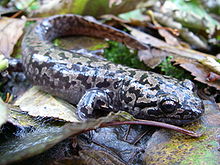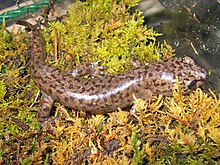Pacific giant salamander
| Pacific giant salamanders | |
|---|---|

| |
| Dicamptodon tenebrosus | |
| Scientific classification | |
| Kingdom: | |
| Phylum: | |
| Class: | |
| Order: | |
| Suborder: | |
| Family: | Dicamptodontidae
|
| Genus: | Dicamptodon
|
| Species | |
|
four extant species | |
Pacific giant salamanders (Dicamptodontidae) are a family of large salamanders.
The family includes only a single genus, Dicamptodon. The genus was formerly thought to contain two species, Cope's giant salamander (D. copei) on the Olympic Peninsula, Washington, and the Pacific giant salamander (D. ensatus) which consisted of three geographic populations, an Idaho isolate, a group in northern California, and a group in Oregon and Washington.[1] In 1989, genetic studies showed D. copei to be a distinct species, and the D. ensatus populations to consist of three species: the Idaho giant salamander (D. aterrimus) in Idaho, and two highly divergent species with a narrow hybrid zone in California, the coastal giant salamander (D. tenebrosus) (ranging from northern California to Washington), and the California giant salamander (D. ensatus) (limited only from Santa Cruz County to Mendocino County in California).[2]
Specimens are up to 30 cm (12 in) long, and are found in the western USA and southwestern British Columbia. Except for their size, they are similar to the mole salamander family (Ambystomatidae), in which they were originally included.[3]
While most salamanders are silent, the Pacific giant salamander is one of several salamanders that have vocal abilities. When startled, these salamanders may respond with a croaky-sounding cry similar to that of a barking dog. Members of this family can either be terrestrial or aquatic as adults.

References
- ^ Ronald A. Nussbaum (1976-04-23). "Geographic variation and systematics of salamanders of the genus Dicamptodon Strauch (Ambystomatidae)" (PDF). Miscellaneous Publications Museum of Zoology, University of Michigan, No. 149. Retrieved 2011-09-29.
- ^ David A. Goode (July 1989). "Hybridization and Cryptic Species in Dicamptodon (Caudata: dicamptodontidae)". Evolution. 43: 728–744. doi:10.2307/2409302. JSTOR 2409302.
- ^ Frost, Darrel R., Grant, Taran, Faivovich, Julián, Bain, Raoul H, Haas, Alexander, Haddad, Celio F. B, De Sa, Rafael O, Channing, A, Wilkinson, Mark, Donnellan, Stephen C, Raxworthy, Christopher J., Campbell, Jonathan A., Blotto, Boris L., Moler, Paul., Drewes, Robert C., Nussbaum, Ronald A., Lynch, John D., Green, David M., Wheeler, Ward C. 2006. The amphibian tree of life. Bulletin of the AMNH; no. 297 (http://digitallibrary.amnh.org/dspace/bitstream/2246/5781/1/B297.pdf)
External links
 Data related to Dicamptodon at Wikispecies
Data related to Dicamptodon at Wikispecies Media related to Dicamptodon at Wikimedia Commons
Media related to Dicamptodon at Wikimedia Commons- Tree of Life: Dicamptodontidae
- Dicamptodon at CalPhotos

